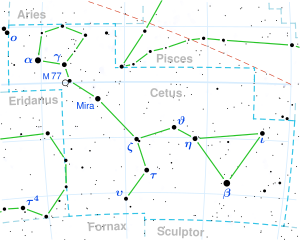GJ 1005
Appearance
| Observation data EpochJ2000EquinoxJ2000 | |
|---|---|
| Constellation | Cetus |
| Right ascension | 00h15m28.11090s[1] |
| Declination | −16° 08′ 01.6303″[1] |
| Apparent magnitude(V) | 11.483[2] |
| Characteristics | |
| Spectral type | M3.5V[3] |
| Astrometry | |
| Radial velocity(Rv) | -26.43 ± 0.1[4]km/s |
| Proper motion(μ) | RA:731.83[1]mas/yr Dec.:-607.73[1]mas/yr |
| Parallax(π) | 166.6 ± 0.3mas[3] |
| Distance | 19.58 ± 0.04ly (6.00 ± 0.01pc) |
| Absolute magnitude(MV) | 12.70 ± 0.01 / 15.12 ± 0.09[3] |
| Orbit[3] | |
| Period(P) | 4.55726+0.00075 −0.00074y.[5] |
| Semi-major axis(a) | 0.3037 ± 0.0005″ |
| Eccentricity(e) | 0.36136+0.00097 −0.00098[5] |
| Inclination(i) | 143.93+0.25 −0.24[5]° |
| Longitude of the node(Ω) | 62.8 ± 0.4° |
| Periastronepoch(T) | JD2449850.4 ± 0.8 |
| Argument of periastron(ω) (secondary) | 166.6 ± 0.5° |
| Details[3] | |
| GJ 1005 A | |
| Mass | 0.179 ± 0.002M☉ |
| Temperature | 3341±224[6]K |
| Metallicity[Fe/H] | -0.41[5]dex |
| GJ 1005 B | |
| Mass | 0.112 ± 0.001M☉ |
| Other designations | |
| Database references | |
| SIMBAD | data |
| ARICNS | A |
| B | |
Location of GJ 1005 in the constellationCetus | |
GJ 1005is a system of twored dwarfs,located inconstellationCetusat 19.6light-yearsfromEarth.[7]The primary star is a M4Vclassstar while the secondary is a class M7V.[citation needed]
The system was observed with theHubble Space Telescopein the 1990s with itsFine Guidance Sensor.[7]This data helped determine the mass of each of the components of L722-22/ LHS 1047 / GJ 1005.[7]
References
[edit]- ^abcdvan Leeuwen, F.; et al. (2007)."Validation of the new Hipparcos reduction".Astronomy and Astrophysics.474(2): 653–664.arXiv:0708.1752.Bibcode:2007A&A...474..653V.doi:10.1051/0004-6361:20078357.S2CID18759600.
- ^Koen, C.; Kilkenny, D.; van Wyk, F.; Marang, F. (2010)."UBV(RI)CJHK observations of Hipparcos-selected nearby stars ".Monthly Notices of the Royal Astronomical Society.403(4): 1949–1968.Bibcode:2010MNRAS.403.1949K.doi:10.1111/j.1365-2966.2009.16182.x.
- ^abcdeBenedict, G. F.; Henry, T. J.; Franz, O. G.; McArthur, B. E.; Wasserman, L. H.; Jao, Wei-Chun; Cargile, P. A.; Dieterich, S. B.; Bradley, A. J.; Nelan, E. P.; Whipple, A. L. (2016)."The Solar Neighborhood. XXXVII. The Mass–Luminosity Relation for Main-Sequence M Dwarfs".The Astronomical Journal.152(5): 141.arXiv:1608.04775.Bibcode:2016AJ....152..141B.doi:10.3847/0004-6256/152/5/141.S2CID54029447.
- ^Nidever, David L.; et al. (2013). "Radial Velocities for 889 Late-Type Stars".The Astrophysical Journal Supplement Series.141(2): 503–522.arXiv:astro-ph/0112477.Bibcode:2002ApJS..141..503N.doi:10.1086/340570.S2CID51814894.
- ^abcdMann, Andrew W.; Dupuy, Trent; Kraus, Adam L.; Gaidos, Eric; Ansdell, Megan; Ireland, Michael; Rizzuto, Aaron C.; Hung, Chao-Ling; Dittmann, Jason; Factor, Samuel; Feiden, Gregory; Martinez, Raquel A.; Ruíz-Rodríguez, Dary; Chia Thao, Pa (2019), "How to Constrain Your M Dwarf. II. The Mass–Luminosity–Metallicity Relation from 0.075 to 0.70 Solar Masses",The Astrophysical Journal,871(1): 63,arXiv:1811.06938,Bibcode:2019ApJ...871...63M,doi:10.3847/1538-4357/aaf3bc,S2CID119372932
- ^Costa-Almeida, Ellen; De Mello, Gustavo F Porto; Giribaldi, Riano E.; Lorenzo-Oliveira, Diego; Ubaldo-Melo, Maria L. (2021), "M dwarf spectral indices at moderate resolution: Accurate Teff and [Fe/H] for 178 southern stars",Monthly Notices of the Royal Astronomical Society,508(4): 5148–5162,arXiv:2110.01658,doi:10.1093/mnras/stab2831
- ^abcHershey, John L.; Taff, L. G. (1998-01-01)."Hubble Space Telescope Fine Guidance Sensor Astrometry of the Low-Mass Binary L722-22".The Astronomical Journal.116(3): 1440.Bibcode:1998AJ....116.1440H.doi:10.1086/300516.ISSN1538-3881.

